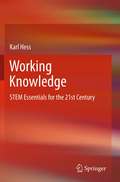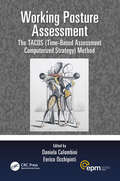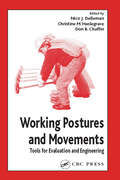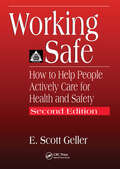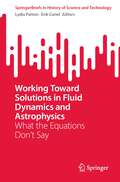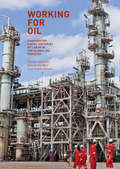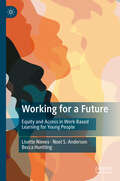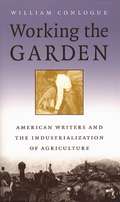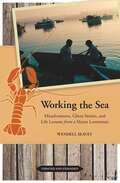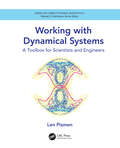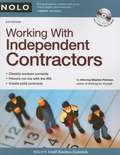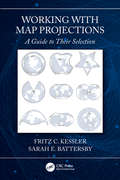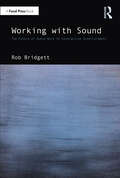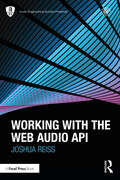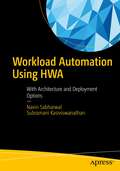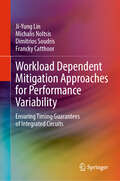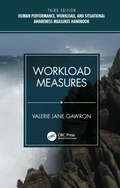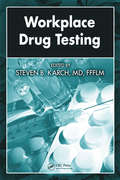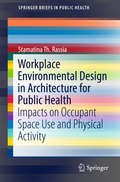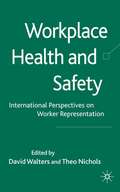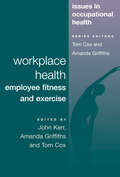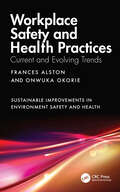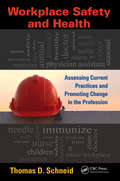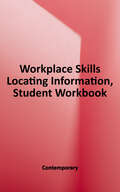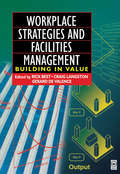- Table View
- List View
Working Knowledge
by Karl HessWorking Knowledge: STEM Essentials for the 21st Century is designed to inspire a wide range of readers from high school and undergraduate students with an interest in Science, Technology, Engineering, and Mathematics (STEM) to STEM teachers and those who wish to become teachers. Written by renowned scientist and teacher Dr. Karl Hess of the University of Illinois at Urbana, a member of both the National Academy of Sciences and the National Academy of Engineering, the book presents a critical collection of timeless STEM concepts and connects them with contemporary research advances in addition to the needs of our daily lives. With an engaging and accessible style not requiring a formal background in STEM, Dr. Hess takes the reader on a journey from Euclidean Geometry and Cartesian Coordinates up through 21st Century scientific topics like the global positioning system, nanotechnology, and super-efficient alternative energy systems. Working Knowledge: STEM Essentials for the 21st Century at once serves as an almanac on the fascinating physical, chemical, quantitative features of the natural world and built environment, as well as a need-to-know list of topics for students, teachers, and parents interested in STEM education.
Working Posture Assessment: The TACOS (Time-Based Assessment Computerized Strategy) Method (Ergonomics Design & Mgmt. Theory & Applications)
by Daniela Colombini Enrico OcchipintiThis book covers how to analyze awkward working postures, particularly of the spine and lower limbs, in specific groups exposed. The methods covered suggests how to evaluate the postures correctly, taking account of the duration and sequence of the tasks involved, even in very complex scenarios where workers are involved with multiple tasks and work cycles varying from day to day. Excel spreadsheets located on the authors’ website (www.epmresearch.org) have been developed to gather, condense, and automatically process the data. The tools serve to implement the strategy for calculating risk associated with exposure to awkward postures, i.e. the TACOS method. Included are 5 case studies which include physiotherapists, workers from construction, archaeological digs, vineyards, and kindergarten teachers. Features Provides a coherent definition of what the study of awkward postures is Clarifies and explains which parameters need to be detected and analyzed for the study of the working postures Defines the phases of a proper organizational study (e.g. tasks, postures, duration, and how often the postures will last) in the working cycle Presents a new and original risk calculation model for awkward postures, with particular attention to the study of the spine and the lower limbs Offers a free excel spreadsheet located on the authors' website which implements the strategy for calculating risk associated with exposure to awkward postures
Working Postures and Movements
by Christine M. Haslegrave Nico J. Delleman Don B. ChaffinIn most industries, musculoskeletal injuries are the most common work-related reason for employee absences. These injuries are often caused by static postures or repetitive movements that have to be maintained for many hours a day, such as intensive use of data entry devices, assembly work, parts inspection, equipment maintenance, manual materials
Working Safe: How to Help People Actively Care for Health and Safety, Second Edition
by E. Scott GellerWritten by world-renowned health and safety researcher E. Scott Geller, Working Safe: How to Help People Actively Care for Health and Safety, Second Edition presents science-based and practical approaches to improving attitudes and behavior for achieving an injury-free work environment. This book teaches proactive applications of behavior-based psychology for improving health and safety. Relevant theory and principles are clearly explained and practical step-by-step procedures are detailed. Dr. Geller's anecdotal and non-academic writing style makes the book fun and easy to read.This research-based text is completely updated and expanded from the 1996 edition. It includes three new chapters: one on behavioral safety analysis, another on intervening with supportive conversation, and the third on how to promote high performance teamwork. Thus, this second edition continues to provide the practical advice safety leaders rely on.Working Safe: How to Help People Actively Care for Health and Safety supplies the research and theory needed to customize effective behavior-based procedures and tools in your workplace. The information and examples provide health and safety professionals with behavioral science methods capable of enhancing safety awareness, reducing at-risk behavior, and facilitating ongoing participation in safety-related activities.
Working Toward Solutions in Fluid Dynamics and Astrophysics: What the Equations Don’t Say (SpringerBriefs in History of Science and Technology)
by Lydia Patton Erik CurielThis book focuses on continuing the long-standing productive dialogue between physical science and the philosophy of science. Researchers and readers who want to keep up to date on front-line scientific research in fluid mechanics and gravitational wave astrophysics will find timely and well-informed analyses of this scientific research and its philosophical significance. These exciting frontiers of research pose deep scientific problems, and raise key questions in the philosophy of science related to scientific explanation and understanding, theory change and assessment, measurement, interpretation, realism, and modeling. The audience of the book includes philosophers of science, philosophers of mathematics, scientists with philosophical interests, and students in philosophy, history, mathematics, and science. Anyone who is interested in the methods and philosophical questions behind the recent exciting work in physics discussed here will profit from reading this book.
Working for Oil
by Touraj Atabaki Elisabetta Bini Kaveh EhsaniThis volume examines the social history of oil workers and investigates how labor relations have shaped the global oil industry during the twentieth century and today. It brings together the work of scholars from a range of disciplines, approaching the social, political, economic and cultural dimensions of oil. The contributors analyze a number of key oil producing regions, including the Americas, the Middle East, Central Asia, the Caucasus, Europe and Africa.
Working for a Future: Equity and Access in Work-Based Learning for Young People
by Noel S. Anderson Lisette Nieves Becca HunttingThis book builds on the success of “Working to Learn" (Palgrave Macmillan, 2020) by focusing on the future of work and how young people, especially low-income young people and young people of color, are pursuing college and career goals through work-based learning experiences, yet encountering an increasingly racially and socioeconomically stratified labor market and educational system. Through policy analysis and case studies both from US and abroad, the authors will present the argument for why these models warrant revisitation, innovation, and investment, and elevate profiles of young workers, nonprofits, corporate partners, and governments today who are using work opportunities to open doors once closed.
Working the Garden
by William ConlogueIn 1860 farmers accounted for 60 percent of the American workforce; in 1910, 30.5 percent; by 1994, there were too few to warrant a separate census category. The changes wrought by the decline of family farming and the rise of industrial agribusiness typically have been viewed through historical, economic, and political lenses. But as William Conlogue demonstrates, some of the most vital and incisive debates on the subject have occurred in a site that is perhaps less obvious--literature. Conlogue refutes the critical tendency to treat farm-centered texts as pastorals, arguing that such an approach overlooks the diverse ways these works explore human relationships to the land. His readings of works by Willa Cather, Ruth Comfort Mitchell, John Steinbeck, Luis Valdez, Ernest Gaines, Jane Smiley, Wendell Berry, and others reveal that, through agricultural narratives, authors have addressed such wide-ranging subjects as the impact of technology on people and land, changing gender roles, environmental destruction, and the exploitation of migrant workers. In short, Conlogue offers fresh perspectives on how writers confront issues whose site is the farm but whose impact reaches every corner of American society.
Working the Sea: Misadventures, Ghost Stories, and Life Lessons From a Maine Lobsterman
by Wendell SeaveyWorking the Sea is the story of a Maine fisherman’s life, a collection of memories and teachings from a master storyteller. <p><p>Author Wendell Seavey, who grew up in the 1940s in the fishing village that inspired this story, avoids the overly romantic or picturesque language of other fishing and working-class narratives, writing in a true Downeast Yankee voice and candidly describing both the joys and hardships of the fishing life. Seavey is firmly rooted in the fishing traditions of his community and family, and the book reflects these deep roots. But his perspectives and observations are unique and at times unexpected as he travels across the United States, engages in psychic and spiritual activity, develops an environmental philosophy of life, and meets a host of memorable countercultural characters. <p><p>Seavey also shares practical lessons about approaching life’s “insurmountable obstacles” and getting past them, and about his transformation from a “fisherman-user” to a “fisherman-ecologist” striving to be part of the cycle of life. <p><p>This new edition includes an account of the author’s two-year sojourn in Texas as well as several other new stories.
Working with Dynamical Systems: A Toolbox for Scientists and Engineers (Series in Computational Biophysics)
by Len PismenThis book provides working tools for the study and design of nonlinear dynamical systems applicable in physics and engineering. It offers a broad-based introduction to this challenging area of study, taking an applications-oriented approach that emphasizes qualitative analysis and approximations rather than formal mathematics or simulation. The author, an internationally recognized authority in the field, makes extensive use of examples and includes executable Mathematica notebooks that may be used to generate new examples as hands-on exercises. The coverage includes discussion of mechanical models, chemical and ecological interactions, nonlinear oscillations and chaos, forcing and synchronization, spatial patterns and waves. Key Features: · Written for a broad audience, avoiding dependence on mathematical formulations in favor of qualitative, constructive treatment. · Extensive use of physical and engineering applications. · Incorporates Mathematica notebooks for simulations and hands-on self-study. · Provides a gentle but rigorous introduction to real-world nonlinear problems. · Features a final chapter dedicated to applications of dynamical systems to spatial patterns. The book is aimed at student and researchers in applied mathematics and mathematical modelling of physical and engineering problems. It teaches to see common features in systems of different origins, and to apply common methods of study without losing sight of complications and uncertainties related to their physical origin.
Working with Independent Contractors (6th edition)
by Stephen FishmanGet the legal lowdown on how to beef up your workforce without risking the ire of the IRS.
Working with Map Projections: A Guide to their Selection
by Fritz Kessler Sarah BattersbyA map projection fundamentally impacts the mapmaking process. Working with Map Projections: A Guide to Their Selection explains why, for any given map, there isn’t a single "best" map projection. Selecting a projection is a matter of understanding the compromises and consequences of showing a 3-D space in two dimensions. The book presents a clear understanding of the processes necessary to make logical decisions on selecting an appropriate map projection for a given data set. The authors discuss the logic needed in the selection process, describe why certain decisions should be made, and explain the consequences of any inappropriate decision made during the selection process. This book also explains how the map projection will impact the map’s ability to fulfill its purpose, uses real-world data sets as the basis for the selection of an appropriate map projection, and provides illustrations of an appropriately and inappropriately selected map projection for a given data set. The authors take a novel approach to discussing map projections by avoiding an extensive inventory of mathematical formulae and using only the mathematics of map projections that matter for many mapping tasks. They also present information that is directly applicable to the process of selecting map projections and not tied to a specific software package. Written by two leading experts, this book is an invaluable resource for anyone studying or working with geospatial data, from students to experienced professionals, and will help readers successfully weigh the pros and cons of choosing one projection over another to suit a map’s intended purpose.
Working with Sound: The Future of Audio Work in Interactive Entertainment
by Rob BridgettWorking with Sound is an exploration of the ever-changing working practices of audio development in the era of hybrid collaboration in the games industry. Through learnings from the pre-pandemic remote and isolated worlds of audio work, sound designers, composers, and dialogue designers find themselves equipped uniquely to thrive in the hybrid, remote, and studio-based realms of today’s fast-evolving working landscapes. With unique insights into navigating the worlds of isolation and collaboration, this book explores ways of thinking and working in this world, equipping the reader with inspiration to sustainably tackle the many stages of the development process. Working with Sound is an essential guide for professionals working in dynamic audio teams of all sizes, as well as the designers, producers, artists, animators, and programmers who collaborate closely with their colleagues working on game audio and sound.
Working with the Web Audio API (Audio Engineering Society Presents)
by Joshua ReissWorking with the Web Audio API is the definitive and instructive guide to understanding and using the Web Audio API. The Web Audio API provides a powerful and versatile system for controlling audio on the Web. It allows developers to generate sounds, select sources, add effects, create visualizations and render audio scenes in an immersive environment. This book covers all essential features, with easy to implement code examples for every aspect. All the theory behind it is explained, so that one can understand the design choices as well as the core audio processing concepts. Advanced concepts are also covered, so that the reader will gain the skills to build complex audio applications running in the browser. Aimed at a wide audience of potential students, researchers and coders, this is a comprehensive guide to the functionality of this industry-standard tool for creating audio applications for the web.
Workload Automation Using HWA: With Architecture and Deployment Options
by Navin Sabharwal Subramani KasiviswanathanApply best practices for deploying and administering HCL Workload automation (HWA) to meet the automation requirements of the digitally transformed platform. This book will provide detailed architecture and deployment options to achieve this goal.Workload automation focuses on real-time processing, predefined event-driven triggers, and situational dependencies. It offers centralized control of managing multiple tasks, making it possible to schedule enterprise-wide tasks. You'll see how it supports the timely completion of tasks and is beneficial for processes that need to happen at a specific time or need to occur as a result of another event. HWA increases efficiency, reduces the turnaround time for workflows, and reduces errors along with delays in end-to-end processes. You'll review proven ways to deliver batch optimization and modernization requirements, and see how solutions can be aligned with the DevSecOps delivery model. Workload Automation Using HWA presents information on how to use the tool and has numerous use cases and implementation procedures to guide every workload automation deployment requirement. What You'll LearnAutomate and integrate your complex workload, workflow, and business processes across automation platforms, ERP systems, and business applicationsUnderstand event-driven batch automationPractice alignment of the workload automation solution with the DevSecOps principlesWho This Book Is ForSolution Architects, Infrastructure Architects, Technical Architects, Enterprise Architects, Workload Automation Tool Administrators or SME’s, Schedulers, Application owners, Automation Specialists, Service Delivery Managers
Workload Dependent Mitigation Approaches for Performance Variability: Ensuring Timing Guarantees of Integrated Circuits
by Dimitrios Soudris Francky Catthoor Ji-Yung Lin Michalis NoltsisThis book provides a holistic view of workload-dependent mitigation techniques for performance variability. The authors describe the use of design-time profiling information to reduce the uncertainties in future execution time calculation at run time, thereby offering the best option for minimizing system costs while reducing missed deadlines. Readers are introduced to an approach that combines dynamic voltage and frequency scaling (DVFS) with heterogeneous datapaths (HDP), enabling users to tackle performance variability of multiple timescales down to the sub-millisecond level.
Workload Measures
by Valerie Jane GawronThis book was developed to help researchers and practitioners select measures to be used in the evaluation of human/machine systems. The book includes definitions of human workload and a review of measures. Each measure is described, along with its strengths and limitations, data requirements, threshold values, and sources of further information. To make this reference easier to use, extensive author and subject indices are provided. Features Offers readily accessible information on workload measures Presents general description of the measure Covers data collection, reduction, and analysis requirements Details the strengths and limitations or restrictions of each measure, including proprietary rights or restrictions Provides validity and reliability data as available
Workplace Drug Testing
by Steven B. KarchExtracted from the Drug Abuse Handbook, 2nd edition, to give you just the information you need at an affordable price.Using sample protocols from the transportation and nuclear power industries, Workplace Drug Testing reviews current federal regulations and mandatory guidelines for federal workplace testing programs and
Workplace Environmental Design in Architecture for Public Health
by Stamatina Th. RassiaThis concise volume analyzes the potential for the workplace environment--where so many people spend so much of their day--to improve workers' capacity for health and wellness. It pinpoints the link between sedentary lifestyles and poor health, and explores the role of office spatial design in encouraging physical activity to promote physical activity, health and prevent disease. The featured research study tracks workers' movement in a variety of office layouts, addressing possible ways movement-friendly design can co-exist with wireless communication, paperless offices, and new corporate concepts of productivity. From these findings, the author's conclusions extend public health concepts to recognize that influencing population-wide levels of activity through office architectural design alone may be possible. This SpringerBrief is comprised of chapters on : Physical activity and disease: Theory and practice Space-use and the history of the office building Identifying factors of the office architectural design that influence movement, Interdisciplinary research methods in studying worker physical activity, decision-making and office design characteristics The KINESIS model for simulating physical activity in office environments The questions and potential for solutions in Workplace Environmental Design in Architecture for Public Health will interest and inform researchers in interdisciplinary topics of public health and architecture as well as graduate and post-graduate students, architects, economists, managers, businesses as well as health-conscious readers.
Workplace Health and Safety
by David Walters Theo NicholsA cutting edge look at the experience of worker representation in the employment relations of workplace health and safety. Examining the extent to which existing arrangements deliver results, this book reflects on whether the effectiveness of worker representation is eroded or enhanced by current regulatory and organizational constructs.
Workplace Health: Employee Fitness And Exercise (Issues In Occupational Health Ser. #Vol. 1)
by John KerrGiven the growing awareness of the negative effects of work-related stress, Many Businesses Are Focusing On Active Health Promotion To Enhance employee health, well-being and performance. This text aims to review the state of the art and offer ideas and suggestions for how stress-related employee health problems can be combated through the provision of effective fitness and exercise programmes.
Workplace Safety and Health Practices: Current and Evolving Trends (Sustainable Improvements in Environment Safety and Health)
by Frances Alston Onwuka OkorieSafety and health concerns in workplaces across the globe continue to be of concern for leaders as they seek to discover novel ways to provide a workplace that preserves the health and safety of workers. To achieve world-class health and safety in any organization, the health and safety of workers must be integrated with technological innovations that monitor, track, and provide feedback on worker performance and safety. These innovations are expected to be comfortable, smart, and even fashionable to achieve increased compliance.Workplace Safety and Health Practices investigates the current and future trends that are leading the way and improving workplace health and safety all over the world. Organized into four parts to provide ease of reading this book focuses on program administration and management engagement and considerations of human aspects for safe and inclusive workplaces. It looks into the identification, mitigation, and control of hazards found at work and the program challenges that are faced along with the development and implementation of improvement measures. The authors provide considerations for novel ways of taking the protection of workers to a higher level considering the evolving definition of the workplace and locations where work takes place. With case studies backing up the theories, the reader will develop a thorough and complex overview of what is working in global workplaces to deliver top-quality health and safety.This book will be a fascinating read for any health and safety professional. Its appeal will extend to industrial hygiene professionals, system engineers, construction engineers, and ergonomics and human factors practitioners.
Workplace Safety and Health: Assessing Current Practices and Promoting Change in the Profession (Occupational Safety & Health Guide Series)
by Thomas D. SchneidAre the tried and true safety practices still effective in the changing workplace? Is there a better way of safeguarding employees from accidents and injuries? In short, why do you perform the safety activities that you do on a daily basis and do they produce the results necessary to keep your safety program and your company competitive in the global market? Answering these questions and more, Workplace Safety and Health: Assessing Current Practices and Promoting Change in the Profession analyzes the current practices and identifies emerging issues and challenges in the safety and health profession.We Need a Game Changer … A New Way of Achieving a Safe and Healthful WorkplaceSafety pioneer and educator Thomas Schneid makes a strong case that mandatory compliance with OSHA regulations is only the first step in a safety program. And that, due to globalization and the current emphasis on sustainability, the requirements of the safety profession have changed. He explores new sources of information and guidance for addressing the new and emerging issues created by the current economic situation, globalization, and the changing workplace. He also identifies and analyzes emerging ethical issues within the safety and health profession, then suggests potential solutions.Schneid then examines the basic assumptions and challenges you to assess and evaluate your activities in search of a better and more effective way of achieving the results necessary to be competitive in today’s workplace. Taking a provocative look at the current issues facing the safety profession, he shows you how to view safety activities and actions from a different perspective and see the real impact they have on the lives of others. He gives you the tools you need to go beyond OSHA compliance and develop safety programs that will be effective in the global workplace and create and maintain a safe workplace that eliminates all injuries and illnesses.
Workplace Skills: Locating Information, Student Workbook (Workforce Series)
by McGraw-Hill ContemporaryProvides vital skills practice for retrieving and using information communicated through graphic sources in the workplace.
Workplace Strategies and Facilities Management
by Craig Langston Rick Best Gerard De ValenceThis book provides comprehensive coverage of issues that facility managers in the property industry need to understand and apply in the pursuit of value for money over the life span of built facilities. The authors introduce the fast-growing discipline of facility management, examine the core competencies that facility managers should possess and study different contemporary drivers of change. The book emphasises the need to consider facilities management issues at the pre-design stage of the construction process, rather than only when the building is completed, in order to maximise value for money.
